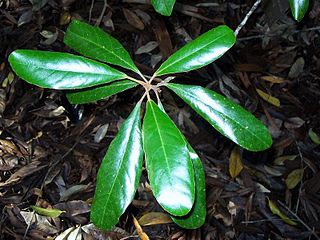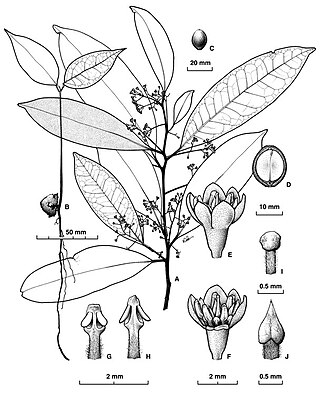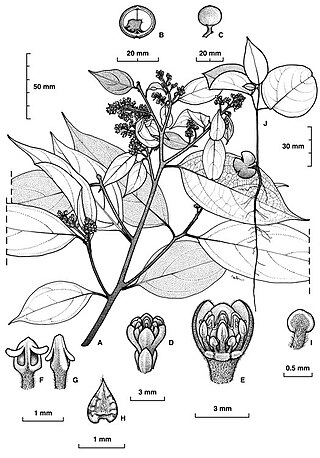
Cryptocarya glaucescens, commonly known as jackwood, is a rainforest tree of the laurel family growing in eastern Australia.

Elaeocarpus holopetalus, commonly known as black olive berry, mountain blueberry, or mountain quandong, is species of flowering plant in the family Elaeocarpaceae and is endemic to eastern Australia. It is a shrub or small tree with regularly toothed, lance-shaped to egg-shaped leaves, racemes of white flowers and black, oval fruit.

Cryptocarya bidwillii, commonly known as yellow laurel, is a species of flowering plant in the laurel family and is endemic to eastern Australia. Its leaves are lance-shaped to elliptic, the flowers creamy-white and tube-shaped, and the fruit an elliptic black drupe.

Elaeocarpus williamsianus, commonly known as hairy quandong, is a species of flowering plant in the family Elaeocarpaceae and is endemic to a restricted area of north-eastern New South Wales. It is a small tree with lance-shaped leaves, racemes of greenish-white flowers and spherical blue fruit.

Acronychia pubescens, commonly known as hairy acronychia or hairy aspen, is a species of tall shrub or small tree that is endemic to eastern Australia. It usually has trifoliate leaves, rarely simple leaves, groups of whitish flowers in leaf axils and creamy to yellowish, elliptical to spherical fruit.

Halfordia is a genus of plants in the family Rutaceae containing the single species Halfordia kendack commonly known as kerosenewood, southern ghittoe or saffronheart, is a rainforest plant that is native to eastern Australia, New Guinea and New Caledonia. It is a shrub or tree with elliptical to egg-shaped leaves with the narrower end towards the base, panicles of white, greenish white or yellowish flowers and purple to bluish black, spherical to oval fruit.
Elaeocarpus stellaris is a species of flowering plant in the family Elaeocarpaceae and is endemic to north-eastern Queensland. It is a tree, sometimes with buttress roots at the base of the trunk, elliptic to egg-shaped leaves, small groups of flowers with greenish-yellow sepals and creamy-white petals, the fruit containing a five-flanged stone.

Cryptocarya corrugata, commonly known as corduroy laurel, oak walnut, acidwood or bull's breath, is a species of flowering plant in the laurel family and is endemic to north Queensland. It is a tree with egg-shaped to elliptic leaves, the flowers creamy-green, slightly perfumed and tube-shaped, and the fruit a spherical black to bluish-black drupe.

Cryptocarya cunninghamii, commonly known as Cunningham's laurel or coconut laurel, is a species of flowering plant in the laurel family and is endemic to northern Australia. It is a tree with oblong to elliptic leaves, the flowers creamy-green and tube-shaped, and the fruit a spherical black to purplish-blackdrupe.

Cryptocarya angulata, commonly known as ivory laurel, ivory walnut, bull's breath or acidwood, is a tree in the laurel family and is endemic to north Queensland, Australia. Its leaves are lance-shaped to elliptic or egg-shaped, the flowers tube-shaped and creamy-green and the fruit a bluish or black drupe.

Cryptocarya bamagana, commonly known as Bamaga walnut, is a tree in the laurel family and is endemic to Cape York Peninsula. Its leaves are lance-shaped to elliptic or egg-shaped, the flowers cream-coloured and tube-shaped, and the fruit a spherical black drupe.

Cryptocarya bellendenkerana is a tree in the laurel family and is endemic to North Queensland. Its leaves are lance-shaped to egg-shaped, the flowers creamy-green and tube-shaped, and the fruit a spherical black drupe.

Cryptocarya brassii is a species of flowering plant in the laurel family and is native to far north Queensland and Papua New Guinea. Its leaves are elliptic to oblong or lance-shaped, the flowers cream-coloured and tube-shaped, and the fruit an elliptic black to bluish-black drupe.

Cryptocarya burckiana is a tree in the laurel family and is native to Cape York Peninsula in Queensland and to Malesia. Its leaves are lance-shaped to elliptic, the flowers cream-coloured and tube-shaped, and the fruit a spherical black drupe.
Cryptocarya cercophylla is a species of flowering plant in the laurel family and is endemism to Wooroonooran National Park in north Queensland. It is a poorly-formed tree with egg-shaped to elliptic leaves, the flowers creamy-green or cream-coloured and tube-shaped, and the fruit an elliptic, red to shiny black drupe.

Cryptocarya clarksoniana, commonly known as Clarkson's laurel, is a tree in the laurel family and is endemic to north Queensland. Its leaves are lance-shaped to elliptic, the flowers creamy-green and tube-shaped, and the fruit a spherical black drupe.

Cryptocarya claudiana, commonly known as Claudie laurel, is a tree in the laurel family and is endemic to Cape York Peninsula in Queensland. Its leaves are oblong to elliptic, the flowers creamy-green, perfumed and tube-shaped, and the fruit an elliptic or spherical black drupe.

Cryptocarya cocosoides, commonly known as coconut laurel, is a tree in the laurel family and is endemic to north Queensland. Its leaves are lance-shaped to elliptic, the flowers creamy-green, perfumed and tube-shaped, and the fruit a spherical black to purple drupe.

Cryptocarya densiflora, commonly known as cinnamon laurel or white laurel, is a tree in the laurel family and is native to north Queensland and parts of Indonesia. Its leaves are lance-shaped to elliptic, the flowers yellowish-green and brown, tube-shaped but not perfumed, and the fruit is a flattened spherical, reddish maroon drupe that turns black when ripe.

Cryptocarya endiandrifolia, commonly known as narrow-leaved walnut, is a species of flowering plant in the family Lauraceae family and is native to Cape York Peninsula and New Guinea. Its leaves are elliptic to oblong or lance-shaped, the flowers cream-coloured or pale green and unpleasantly perfumed, and the fruit is a spherical to elliptic black drupe.


















